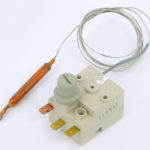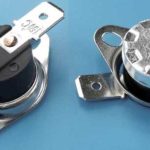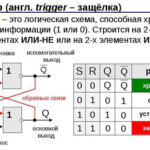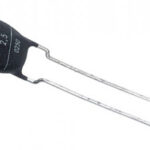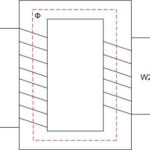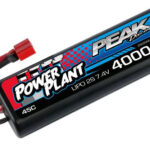Refrigeration equipment and complexes for air cooling are indispensable elements in everyday life. However, standard volumetric designs based on refrigerants are not suitable for mobile applications, for example in refrigerator bags. In such cases, devices based on the Peltier effect are used, which we will discuss in detail in this material.

The Peltier element or thermoelectric cooler is based on a thermocouple of two elements with p- and n-type conductivity, which are connected by a commutation copper plate. The parts are in most cases made of bismuth, tellurium, antimony and selenium. Such devices are used in cooling systems for domestic applications, and they also have the ability to generate energy.
Contents
What is it
The phenomenon and the term Peltier suggest a discovery made in 1834 by the French scientist Jean-Charles Peltier. The essence of the discovery is that heat is constantly released or absorbed in the area where there is contact between two differently directed conductors, through which the electric current flows.
Classical theory explains this phenomenon this way: electrons are transferred between metals by means of electric current, accelerating or slowing down, depending on the contact potential difference on the metal conductors with different levels of conductivity. Peltier elements thus contribute to the transformation of kinetic energy into thermal energy.
On the second conductor, the opposite effect occurs, where energy replenishment is required based on the fundamental law of physics. This situation occurs due to the process of thermal oscillation, as a result of which the metal of the second conductor is cooled.
With the help of modern technology it is possible to manufacture a Peltier module with the maximum thermoelectric effect.
Design and principle of operation
Modern Peltier modules are a construction with two insulator plates, with thermocouples connected in a strict sequence between them. A standard diagram of this element for a better understanding of its functioning is shown in the figure.
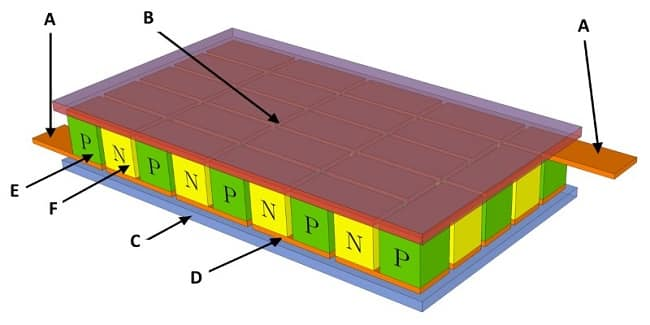
Designation of the elements of the design:
- A - contacts, by which the connection to the power supply is made;
- B - hot surface;
- C - cold side;
- D - copper conductors;
- E - p-junction semiconductor;
- F - n-type semiconductor.
The element is made so that both surfaces are in contact with p-n or n-p junctions, based on polarity. The p-n contacts are heated and the n-p temperature is reduced. The result is a temperature difference of DT at the ends of the element. This effect means that the thermal energy, which moves between the elements of the module, regulates the temperature regime depending on the polarity. It should also be noted that if the polarity is reversed, the hot and cold surfaces change.
Technical characteristics
The technical parameters of the Peltier element assume the following values:
- Cooling capacity (Qmax) - calculated on the basis of the current limit and the temperature difference between the ends of the module. The unit of measure is Watt;
- temperature difference limit (DTmax) - measured in degrees, this characteristic is given for optimum conditions;
- Imax - the limiting power of the electric current required to provide a greater temperature difference;
- Umax - the limiting voltage that is required for the electric current Imax to achieve the maximum temperature difference DTmax;
- Resistance - internal resistance of the device, measured in ohms;
- COP is the efficiency factor or Peltier module efficiency, which reflects the ratio of cooling power to consumed power. Depending on the features of the device, for inexpensive devices the figure is in the range 0.3-0.35, for more expensive models it varies up to 0.5.
The advantages of a mobile Peltier element are its small size, reversibility of the process, as well as the possibility of using it as a portable power generator or refrigerator.
The disadvantages of the module are high cost, low efficiency within 3%, high power consumption and the need to constantly maintain the temperature difference.
Application
Even considering the low efficiency factor, the plates in the Peltier module are widely used in measuring, computing devices, as well as in portable household appliances. Here is a list of devices in which models are an integral part:
- portable refrigeration units;
- small power generators;
- cooling complexes in PCs and laptops;
- coolers for heating and cooling of drinking water;
- dehumidifiers.
How to connect
You can connect the Peltier module yourself, it does not require much time and effort. You need to apply DC voltage to the contacts of the outputs, which is specified in the instruction manual of the device. The red wire is connected to the plus, and the black - to the minus. Note that reversing the polarity will reverse the heated and cooled surfaces.
Before connecting, it is recommended to check the operation of the element. One simple and reliable way to test the device is the tactile method: to do this, connect the device to a source of electric current and touch the different contacts. A properly functioning unit will have warm contacts and cooled contacts.
You can also check with a multimeter and a lighter. To do this, connect the probes to the contacts of the device, hold the lighter to one side and observe the multimeter reading. If the Peltier element works in standard mode, the heating process will produce an electric current on one side and the voltage reading will be displayed on the screen of the multimeter.
How to make a Peltier element with your own hands
Peltier element is inexpedient to make at home due to the low cost and the need for special knowledge to create a workable element. However, with your own hands you can assemble an effective mobile thermoelectric generator, which will come in handy in the country house or on a camping trip.
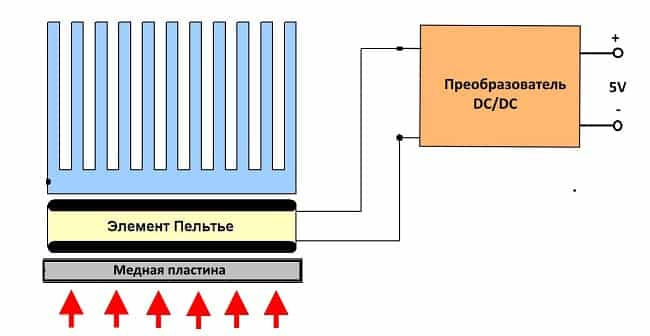
In order to stabilize the electric voltage you will need to build yourself a standard converter on the IC chip L6920. It is necessary to supply voltage of 0.8-5.5 V to the input of the device, and at the output it will produce 5 V, this value is enough to charge the battery of mobile devices in standard mode. If a standard electronic Peltier device is used, then it will be necessary to limit the temperature limit of the heated surface to 150 degrees. For ease of temperature control, it is advisable to use a pot of boiling water, then the model will not be heated above 100 degrees.
Peltier plates are widely used for cooling modern household appliances, in air conditioners, the effectiveness of the device has been proven in particular to stabilize the thermal regime and cool a powerful processor. Based on the Peltier element, efficient mobile refrigerators are often made at home for summer cottages or cars, powering a radiator. Due to the reversibility of the process, homemade elements are used in the role of mobile small power plants in areas without a source of electricity.
Related articles:
